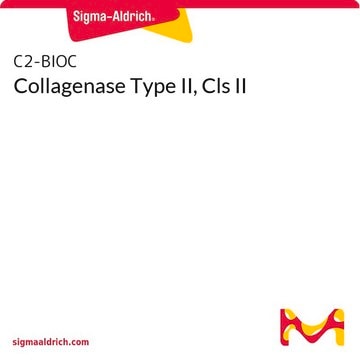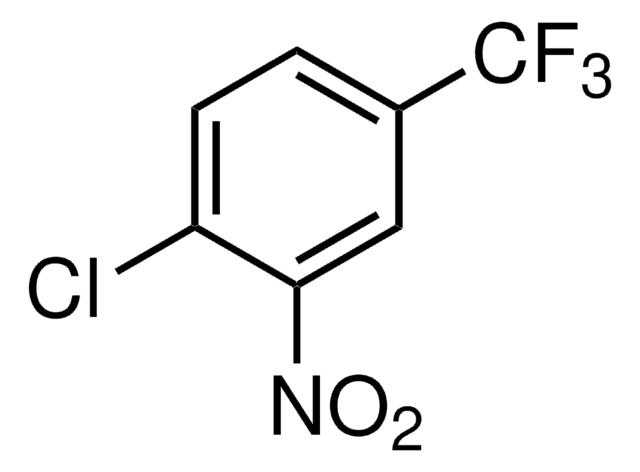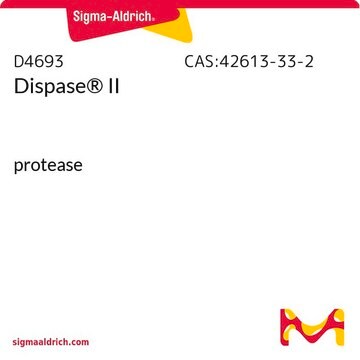COLLB-RO
Roche
Collagenase B
from Clostridium histolyticum
Sign Into View Organizational & Contract Pricing
All Photos(1)
About This Item
Recommended Products
biological source
Clostridium histolyticum
Quality Level
sterility
non-sterile
form
lyophilized
packaging
pkg of 100 mg (11088807001)
pkg of 2.5 g (11088831001)
pkg of 500 mg (11088815001)
manufacturer/tradename
Roche
concentration
0.5-2.5 mg/mL
optimum pH
6.0-8.0
application(s)
sample preparation
storage temp.
2-8°C
General description
Collagenase B is prepared from Clostridium histolyticum cultures by filtration, ammonium sulfate precipitation, dialysis, and lyophilization. Collagenase from Clostridium histolyticum is a collagenolytic enzyme. It interacts with collagen-like substances and is responsible for the degradation of collagen into small peptides. It is widely used for the disaggregation of many types of tissues (e.g., lung, heart, muscle, bone, adipose tissue, liver, kidney, cartilage, mammary gland, placentae, blood vessels, brain, tumors) and for the preparation of single-cell suspensions for the establishment of primary cell culture systems. Collagenase B is recommended when yield and viability are important.
Specificity
Collagenase degrades native collagen. Clostripain, trypsin-like enzymes, and neutral proteases degrade other proteins as well.
Application
Clostridium collagenase from Roche has been used to prepare cells from many types of tissue, such as hepatocytes, adipocytes, pancreatic islets, epithelial cells, muscle cells, endothelial cells, etc. However, suitability of each lot of the enzyme for disruption of a particular tissue should be determined empirically.
Collagenase B has been used for preparation of cells from mouse aortas and colorectal cancer tissue.
Collagenase B has been used for preparation of cells from mouse aortas and colorectal cancer tissue.
Specifications
Enzyme activity:
Collagenase activity: >0.15U/mg (according to Wünsch) (+25°C, 4-phenyl-azobenzyl-oxycarbonyl-Pro-Leu-Gly-Pro-D-Arg as the substrate)
Contaminating enzyme activities: trypsin, clostripain, and total proteolytic activity
Collagenase B has a normal to high collagenase activity and a higher than average clostripain activity (usually >10U/mg).
Inhibitors:
Collagenase inhibitors: EDTA, EGTA, Cys, His, DTT, 2-mercaptoethanol
Collagenase is not inhibited by serum.
Clostripain inhibitors: TLCK
Trypsin inhibitors: aprotinin, trypsin inhibitor (egg white, soybean), serum
Collagenase activity: >0.15U/mg (according to Wünsch) (+25°C, 4-phenyl-azobenzyl-oxycarbonyl-Pro-Leu-Gly-Pro-D-Arg as the substrate)
Contaminating enzyme activities: trypsin, clostripain, and total proteolytic activity
Collagenase B has a normal to high collagenase activity and a higher than average clostripain activity (usually >10U/mg).
Inhibitors:
Collagenase inhibitors: EDTA, EGTA, Cys, His, DTT, 2-mercaptoethanol
Collagenase is not inhibited by serum.
Clostripain inhibitors: TLCK
Trypsin inhibitors: aprotinin, trypsin inhibitor (egg white, soybean), serum
Unit Definition
Collagenase from Roche is assayed in Wünsch units (1 μmol of product formed per minute at +25 °C with Wünsch substrate).
Frequently, collagenase activities are given in Mandl units (1 μmol leucine liberated from collagen in 5 hours at +37 °C).
Unfortunately, there is no consistent conversion factor between the two units of activity, since the Mandl unit depends, in part, on the concentration of contaminating proteases in the collagenase preparation, an indefinable variable. A purer collagenase preparation would actually give a lower specific activity in Mandl units than a crude preparation. Clostridium preparations typically give conversion factors of approximately 1:1800 (e.g., a particular lot of Clostridium collagenase contained approximately 0.15 Wünsch U/mg and 250 Mandl U/mg).
Frequently, collagenase activities are given in Mandl units (1 μmol leucine liberated from collagen in 5 hours at +37 °C).
Unfortunately, there is no consistent conversion factor between the two units of activity, since the Mandl unit depends, in part, on the concentration of contaminating proteases in the collagenase preparation, an indefinable variable. A purer collagenase preparation would actually give a lower specific activity in Mandl units than a crude preparation. Clostridium preparations typically give conversion factors of approximately 1:1800 (e.g., a particular lot of Clostridium collagenase contained approximately 0.15 Wünsch U/mg and 250 Mandl U/mg).
Preparation Note
Activator: Ca2+
Working concentration: 0.5 to 2.5 mg/ml
Storage conditions (working solution): -15 to -25 °C
Roche recommends reconstituting only the amount of lyophilizate needed for immediate use. The reconstituted solution can be stored at -15 to -25 °C for up to one week. Avoid repeated freezing and thawing since activity decreases after reconstitution.
Working concentration: 0.5 to 2.5 mg/ml
Storage conditions (working solution): -15 to -25 °C
Roche recommends reconstituting only the amount of lyophilizate needed for immediate use. The reconstituted solution can be stored at -15 to -25 °C for up to one week. Avoid repeated freezing and thawing since activity decreases after reconstitution.
Reconstitution
Reconstitution in any balanced salt solution (e.g., HBSS)
Other Notes
For life science research only. Not for use in diagnostic procedures.
Signal Word
Danger
Hazard Statements
Precautionary Statements
Hazard Classifications
Eye Irrit. 2 - Resp. Sens. 1 - Skin Irrit. 2 - STOT SE 3
Target Organs
Respiratory system
Storage Class Code
11 - Combustible Solids
WGK
WGK 1
Flash Point(F)
does not flash
Flash Point(C)
does not flash
Choose from one of the most recent versions:
Already Own This Product?
Find documentation for the products that you have recently purchased in the Document Library.
Customers Also Viewed
Bo Jin et al.
Laboratory investigation; a journal of technical methods and pathology, 85(8), 992-1002 (2005-06-21)
The regression of cirrhosis is associated with increased intrahepatic collagenolytic enzyme activity. We investigated whether collagenase supplementation via portal vein infusion can retard cirrhosis development and/or reverse cirrhosis. In all, 35 rabbits were initially assigned to study. However, because of
Hongming Miao et al.
Nature communications, 7, 11716-11716 (2016-05-18)
Metabolic reprogramming in stromal cells plays an essential role in regulating tumour growth. The metabolic activities of tumour-associated macrophages (TAMs) in colorectal cancer (CRC) are incompletely characterized. Here, we identify TAM-derived factors and their roles in the development of CRC.
Wuzhou Wan et al.
Cardiovascular research, 97(3), 580-588 (2012-11-28)
Recent evidence suggests that both Ccr7 and its ligands, Ccl19 and Ccl21, are present in mouse and human atherosclerotic plaques; however, the role of Ccr7 in atherogenesis is still controversial. Here, we addressed this question by using the classic apolipoprotein
Our team of scientists has experience in all areas of research including Life Science, Material Science, Chemical Synthesis, Chromatography, Analytical and many others.
Contact Technical Service













